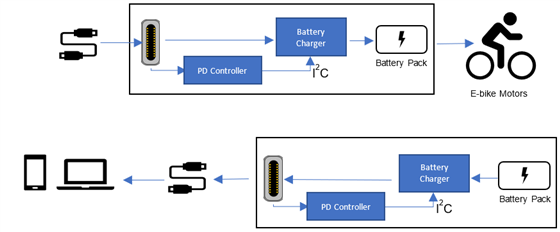SSZTD04 October 2023 BQ25756 , TPS26750
It can be challenging for engineers to design applications using rechargeable batteries that provide the best charging experience for consumers when different projects have different battery-charging needs. Using a different battery charger for every application increases design time because you have to redesign, debug and requalify every new circuit.
What if you could minimize development time by selecting a battery charger that worked for a variety of projects? A single battery-charger integrated circuit (IC) with wide voltage input (VIN) and voltage output (VOUT) capability can help reduce development time by enabling you to use the same charger across a variety of applications with different input adapters and battery configurations.
In addition to helping reduce design time, using a wide VIN and VOUT charger helps you explore new technologies such as solar and bidirectional charging, which can improve the charging experience for consumers. In this article, I’ll discuss the benefits of a wide VIN and VOUT buck-boost battery charger.
Supporting multiple designs using a single battery charger IC
Designing a battery-charging system for e-bikes is one application example that would benefit from using the same battery-charger IC across models. There is a new USB Power Delivery (PD) standard called Extended Power Range (EPR), with output power as high as 240W and VIN up to 48V. Because of the higher EPR power and convenience of using a standard USB Type-C® adapter, designers are looking to implement USB PD EPR charging for e-bikes, which requires the integration of a battery-charger IC into the e-bike battery pack.
E-bike companies have different models with different battery chemistries and charge voltages. Instead of using one battery charger to charge an e-bike with a 36-V battery and another battery charger to charge an e-bike with a 48-V battery, it would be more convenient to use the same battery charger for both models. Supporting the full voltage range of USB PD EPR adapters would also help minimize the amount of design changes necessary between models. To use the same battery charger, it must have a wide VIN to support the USB PD EPR input and a wide VOUT to support 36- to 48-V batteries.
Related to USB PD EPR, bidirectional charging is a new feature enabled by a wide VIN and VOUT battery charger. As shown in Figure 1, it is possible to charge a battery such as an e-bike battery when the battery charger is in forward mode and discharge the battery in reverse mode from the same USB Type-C port. This benefits consumers because the application has new functionality – being a power bank in addition to its usual operation. Supporting functionality as a power bank requires a battery charger with a wide VIN and VOUT and bidirectional charging in order to support the various input and output voltage combinations in forward and reverse mode.
 Figure 1 Charging e-bike from USB (top) and charging personal device from e-bike (bottom)
Figure 1 Charging e-bike from USB (top) and charging personal device from e-bike (bottom)Solar charging with different sunlight intensity
Solar panels offer a way for consumers to charge their products without grid-dependent outlets nearby. It is important to find the maximum power point (MPP) of the solar panels because their output serves as the input for the battery charger, as shown in Figure 2. A lower input power to the battery charger will have a lower charge current, resulting in longer charge times. A battery charger with a maximum-power-point tracking (MPPT) algorithm will autonomously find the MPP of the solar panel under different sunlight conditions. Using a wide VIN and VOUT buck-boost battery charger helps support the range of possible output-voltage values of the solar panel.
 Figure 2 Solar charging block diagram
Figure 2 Solar charging block diagram |
A portable power station would also benefit from a charger with an MPPT algorithm. For solar charging applications, designing the charging system using a battery charger with an autonomous MPPT algorithm helps fully harness the solar panel for shorter charge times.
Battery charger for wide VIN and VOUT
The BQ25756 buck-boost battery charger supports a 70-V operating voltage on the input and output and as much as 20 A of charge current, which meets the 240-W maximum USB PD EPR power levels. In addition to a wide VIN and VOUT range, the BQ25756 is also a bidirectional battery charger for charging and discharging through the same USB Type-C port. The device comes equipped with an advanced MPPT algorithm for solar charging, and can even find the MPPT with multiple solar panels connected in series or parallel with various sunlight conditions including partial shade. Using the wide VIN and VOUT, bidirectionality, and MPPT functionality of the BQ25756 enables its use across many designs.
Conclusion
Designing with a wide VIN and VOUT charger helps save engineers development time by reusing the same circuity across many applications. Image you need to design a new portfolio of power tools. Choosing a different battery charger for the drill, heat gun and blower can increase the work as you need to learn about three chargers. Using the same charger across these power tools helps save the learning and development time compared to using multiple different chargers.
In addition, wide VIN and VOUT chargers enable engineers to incorporate new technologies, such as USB Type-C™ Power Delivery and solar charging. Using a wide VIN and VOUT charger like BQ25756 with an MPPT algorithm helps engineers design products that can be charged anywhere with solar panels while providing the consumers with a fast charging experience. Pairing BQ25756 with a TI USB-C PD Controller eliminates the hassle of having adapters that work for only one device. With this pairing, consumers can leverage bi-directional charging and use a common USB-C adapter to charge many applications including power tools, e-bikes and portable power stations. Wide VIN and VOUT chargers can improve the customer charging experience and reduce your development time.